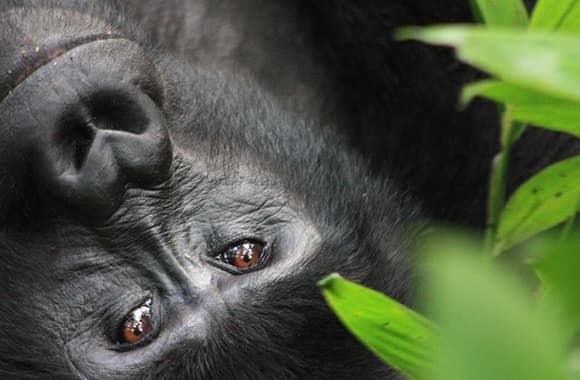More than Counting Gorillas: The hidden value of a census
Advocacy | 27/09/11
Yes, a census is about getting the population numbers of mountain gorillas and their distributions within the forest. But what goes on in the course of conducting the census is, in some ways, much more valuable than the results themselves.
On my third and last day checking in on the census in Bwindi last week, I sat in on the first day of training for the teams responsible for Phase II (who are now all in the forest applying what they learned) and witnessed the forging of new connections among colleagues from different backgrounds and different languages.
The day started very quietly, with participants coming early and quietly, tentatively shaking hands and offering greetings to each other. Conservation Manager for Bwindi-Mgahinga Conservation Area, Pontious Ezuma, picked it up right from the beginning of his formal welcome of the assembled conservationists. He commented how quiet it was in the room and how it was probably due to the fact that we didn’t know each other. After a round of self-introductions, the more than 40 participants could then be identified by country of origin and by institution of origin.

Pontious Ezuma, Conservation Area Manager of Bwindi-Mgahinga for the Uganda Wildlife Authority, welcomes the approximately forty trainees.
Among that 40 included staff of Kahuzi-Biega National Park in DRC, Virunga National Park in DRC, Volcanoes National Park in Rwanda, Mgahinga Gorilla National Park in Uganda, and Bwindi Impenetrable National Park in Uganda. In addition, there were representatives from many organizations including Karisoke Research Center in Rwanda, the Mountain Gorilla Veterinary Project in Uganda, the Institute for Tropical Forest Conservation in Uganda, Conservation through Public Health in Uganda, and of course IGCP. Those seated in the room had various experiences, some having participated in multiple previous censuses, some were researchers, others guides and trackers, and still others worked in park management.

First day of training for participants in the 2011 census of Bwindi's mountain gorillas, coming from DRC, Rwanda and Uganda.
Ezuma then went on to eloquently point out how the scientific world was waiting for the results of the work they were about to do, and indeed the world was waiting for the results of the work they were about to do. Work they would do together.
In addition to the participants, those doing the training represented the Max Planck Institute (Dr. Martha Robbins and doctoral student Edward Wright), Makerere University (Dr. Mugisha), and IGCP (Dr. Augustin Basabose). Lots of Drs.- or soon-to-be Drs. in Edward’s case- present, but each one had their niche in what part of the training they facilitated. Transitioning with equal enthusiasm between English and French, somehow the trainers hit their stride quickly and maintained it, all very skilled at openly transferring knowledge and skills to the group assembled.

Staff from Kahuzi-Biega National Park flanked the first row and actively engaged in the training, offering advice as well as asking question.

Lawrence Mugisha. Can you tell from his shirt that he would normally consider himself a 'chimp guy?' If you can't read it, it says "98.7% chimpanzee."
Throughout the day, participants started to mingle with each other, try their hand at finding a common language with their counterparts, Swahili being the most universal. Throughout the discussion of health and safety, use of a map and compass, and all the functions of a GPS unit, people started to learn from each other.

IGCP's Species Coordinator, Augustin Basabose, reviews orientering with a group between training sessions.

Warden for Bwindi's Nkuringo Sector, James Busiku (right) and 'Gorilla Doctor' Fred Nizeyimana work together to solve a GPS challenge during the training.
Opportunities for a group like this, the real ‘boots-on-the-ground’ conservationists working in the region is rare. But what makes a transboundary exercise like the census of mountain gorillas so transformative is that it gives this diverse group of conservationists a chance to work together on something tangible, on difficult terrain, and close quarters. They will depend on each other in real ways as each team on the ground contains members with a range of experience level as well as a mixture of origins. The camaraderie within these teams is off the charts and is the foundation for all transboundary collaboration related to conservation and maybe even beyond that as well.
I have asked several members of this group that is now in the forest to keep a diary of their experience from their own personal view, the ups and downs and how they made it through the two weeks of Phase II as a team. I hope that in the coming weeks I can share with you through this blog what the census is like through their eyes.
I find that I lack words to describe how powerful these transboundary exercises on the ground can be. Speaking to participants and those who have participated in past censuses, I know that the bonds formed during these few weeks are some of the most valued experiences for those involved. It became the overwhelming theme for my few days in Bwindi and has stayed with me since.
Efforts like these that bring people together from the three countries are the hallmark of the work that IGCP has done over the last 20 years and what we will continue to do in the decades to come. We will continue to go out of the way to bring these everyday conservation heroes together, because there may be no real way to measure, or count, its value.
Have you participated in one of these transboundary activities before, like a coordinated patrol or a census? Write a comment and tell us about it or send to info@igcp.org.

